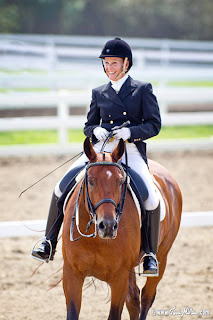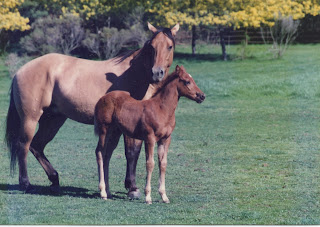by Laura Crum
So
at this point I had two horses-- my ranch horse, Burt, and my expensive new
three year old colt, Gunner. I was twenty-six years old and working for minimum
wage for a well known reined cowhorse trainer, and I could barely afford to own
one horse, let alone two. But the trainer was so impressed with Gunner that he
offered to board and train the colt for free if I would let him show the horse.
That’s how talented Gunner was.
There
was just one slight problem with this program. And it was that I could not bear
to let the trainer torture Gunner.
I
had seen first hand how hard the three year olds were pushed to make them
competitive at the Snaffle Bit Futurity and I didn’t want to do this to my
colt. I had about had a bellyful of seeing horses pushed too hard in order to
win…on all fronts.
So
in a fit of anger, sensible or not, I quit the trainer and took Gunner home—to
get him ready to show at the Snaffle Bit Futurity all by myself.
This
was a pretty unrealistic concept. I had never shown at the Snaffle Bit before
and I had never trained a horse to be a successful reined cowhorse. But I had
ridden for the big time cowhorse trainer for all of a year, and I thought I
knew enough. Remember, I was twenty-six years old.
So
I loaned Burt to a ranching family that I knew, and I spent all my time and all
my money training Gunner. I practiced with my colt at our family ranch. Here we
are, cutting cattle.
I
took lessons from trainers as I could afford it. And I rode Gunner every single
day (poor thing). He was a really talented horse and I made a lot of progress
with him. But he was still a homemade horse and I was very green at showing.
Virtually every other non-pro at the Snaffle Bit Futurity was on a professionally
trained horse and had many more years of experience than I had. So I’m actually
proud to say that we placed in the non-pro and the ladies division. I didn’t
win enough to earn back my entry fees and I made some dumb mistakes, but
overall we did OK. However, the whole experience really soured me on the reined
cowhorse business.
It was just too hard on the horses
and too political, and I thought (I believe rightly) that I wasn’t ever going
to be much of showman, especially in the reining part of the contest. If I
didn’t have a cow to focus on, I wasn’t happy. So I took up cutting instead,
and began hauling Gunner to cutting competitions.
By this time I was working for a
well known cutting horse trainer, and I knew quite a bit more about training a
horse to be a cutting horse than I had known about training one to be a reined
cowhorse. I hauled Gunner to all the small local cuttings that I could.
Sometimes we did pretty well. But almost every time I went to a larger show we
bombed.
Obviously the competition was
tougher. But there was something else, too. Whenever I pulled into the parking
lot of one of these bigger shows, I was the ONLY half-ton pickup towing a
two-horse trailer in the entire parking lot (older pickup with a shabby old two
horse trailer, at that). I am not kidding. Every other rig was a shiny dually
towing an equally shiny multi-horse trailer, many with living quarters. By
which you can see the difference between my degree of wealth and that of the
other participants.
Cutting is a rich man’s sport.
There are a number of reasons for this. Cutting horses are expensive, cattle
are expensive, entries at a cutting are expensive. But there’s more to it than
that. Cutting is one of the few horse sports where you really CAN buy your way
in. A rich man can buy a well-trained cutting horse, he can keep it in training
with a good cutting horse trainer, he can take the occasional lesson, and he
can climb on that horse at a show and have his trainer coach him through a
run…and he can win the class. Unlike the reined cowhorse world, you can be a
pretty poor rider (by which I mean you could never survive going down the fence
or manage to cue a horse for a good sliding stop), and still ride a polished
cutting horse who knows his job and—with a little coaching—perform pretty damn
well. And thus, the cutting horse world is populated by a lot of VERY rich
people who don’t actually ride very well. But boy do they have nice horses.
When I showed up at the bigger
cuttings, not only did I usually have the only “humble” rig in the parking lot,
I was frequently the only non-pro on a homemade horse. Every other non-pro kept
his/her horse in training with a professional trainer, who was there to tune
the horse up and coach the non-pro through his/her run. As you can imagine, I
seldom beat these people. Partly because the professionally trained horses were
more solid than Gunner overall, and the other non-pros were usually far more
experienced at showing. But there was another element in play.
I had taken up cutting not only
because it was easier on the horse than cowhorse, but also because I thought
the judging was less subjective. If you lose a cow, you get marked down a
specific number of points. Same for switching a cow, or bumping the bit…etc. A
judge cannot just let any horse he likes win a class. But…if two horses both
have clean runs and neither gets a whole lot more accomplished than the other,
well, a judge marks them higher or lower as he pleases. I did occasionally have
a pretty good run, but guess what? It wasn’t often marked high enough to win.
And there’s a reason for this.
The judges were usually trainers.
They all knew each other, they all knew the rich clients who typically
circulated around from trainer to trainer. They knew who had money and was
worth cultivating because some day that person might put a horse in training
with that judge. They knew if they marked a trainer friend’s client high enough
to win a class that trainer friend might return the favor. So if a non-pro with
no money and no trainer has a run that’s more or less the equal of a non-pro
who is the wealthy client of well known trainer, who do you suppose will get
marked higher? And yes, it does work like that. Not all the time, but a lot of
the time.
So I placed a little and won the
occasional class at a smaller show and collected some trophy buckles and
headstalls, but I began to find cutting frustrating. I’ve already explained
about the judged element and how political it was, but there were other things.
There weren’t many local cuttings near me—I usually had to haul at least three
hours (one way) to get to an event. The entries were very expensive, several
hundred dollars per class at a large show. In order to practice effectively,
one needed access to fresh cattle, and no matter how you attempted to arrange
this, it was expensive (believe me I know all about this). And finally, except
when you are actually showing, or watching someone else have a good run,
cuttings are like watching paint dry. An endless amount of sitting around while
the herd is being settled and the arena is being drug for the occasional few
seconds of brilliance on the part of a good horse, and one’s own two and a half
minute run, which was frustrating as often as it turned out rewarding. I just
plain got burnt out on it.
And finally, I had progressed as
far as I thought I was going to go on Gunner at this sport. Gunner was a solid
cutting horse. Two local trainers had told me he was a good horse and I had
done a good job on him…but he wasn’t going to get any better unless I let a
trainer ride him. One trainer had offered to train and show him for free (he
obviously liked Gunner) if I would pay his entry fees. One trainer had offered
me $10,000 for Gunner for a wealthy non-pro client who wanted a gentle all
around horse that he could win the occasional cutting on. And every single
trainer told me that if I wanted to improve and “go on” at cutting, I needed to
move on to a different horse. A smaller, cattier, fancier kind of horse. But I
didn’t want to sell Gunner. And I was getting tired of the politics and
logistics of this rich man’s sport.
So in Gunner’s nine-year-old year I
resolved that my last cutting would be our local county fair. And what do you
know? We marked a 72 and a half (about like an A-) and won the class. I got a
big fancy buckle and that was our last cutting event. Here we are, winning the
county fair cutting.
But Gunner’s career wasn’t over.
Far from it. The poor horse was bred to be a reined cowhorse, and he was pretty
damn successful as a cutter, considering that I trained him myself every step
of the way. But all my friends at this time were team ropers, and team roping
is timed rather than judged (no politics—yay!), and boy howdy does it move
along compared to cutting, and the entry fees are SO MUCH cheaper. Not to
mention that my uncle had a practice arena where my friends roped together
twice a week. And so I decided that I would train my long suffering horse to do
yet another event. He was about to become a team roping head horse. (To be
continued.)
And if you would like to read a
more colorful description/rendition of the cutting horse world than I can
provide in a blog post, complete with the driven trainers, wealthy clients and
amazing horses that I knew (names changed to protect the innocent and the
guilty, of course), try my first mystery novel,
Cutter, on sale as a Kindle
edition for 99 cents. Click on the title to find the book.
 When I researched my mystery Shadow Horse, I spent time at a rescue farm where the volunteers went to auctions and bought horses that were slated to go to the killers. One was an old pony who had faithfully served a family until she was twenty-five and no longer healthy. An auction was her reward. The rescue farm bought her so she could have a gentle ending. The other was a strapping, rambunctious yearling Percheron cross that came from a farm with too many horses. He was in quarantine when I met him; I am hoping he found a good home (and some manners.)
When I researched my mystery Shadow Horse, I spent time at a rescue farm where the volunteers went to auctions and bought horses that were slated to go to the killers. One was an old pony who had faithfully served a family until she was twenty-five and no longer healthy. An auction was her reward. The rescue farm bought her so she could have a gentle ending. The other was a strapping, rambunctious yearling Percheron cross that came from a farm with too many horses. He was in quarantine when I met him; I am hoping he found a good home (and some manners.)



































